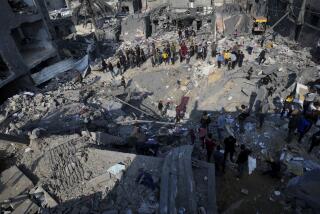Commentary: The Deadly Cost of Selective Bombing
Reports of American and British combat casualties in ambushes and skirmishes, of captured allied soldiers, of “friendly fire” hits, of the grenade attack that a soldier of the 101st Airborne allegedly carried out against his own commanders and other such incidents are just that -- incidental events on the margins of the main event: the almost unopposed advance of U.S. forces toward Baghdad and combined U.S.-British forces on Basra.
Each combat death is an infinite tragedy for the individual himself, his family and friends, but, given the scale of this war, the total number of casualties so far can only be described as insignificant.
The reason is obvious: Ignoring war plans, orders and Saddam Hussein’s exhortations, Iraqi divisions with their hundreds of tanks and thousands of soldiers are not fighting divisional battles to confront the entire offensive toward Baghdad. American and British air supremacy does not explain this lack of organized resistance. Even with perfect precision, it would have taken weeks of airstrikes, not mere days, to incapacitate the large Iraqi formations that have been overrun so far.
Up to now, these Iraqi formations -- roughly a third of the army -- have simply refused to fight.
The media have reported isolated episodes of Iraqis fighting back. But major offensives cannot be stopped by skirmishing on the edges, and, indeed, American forces keep advancing deep into Iraq.
No advance in the history of warfare has been anywhere nearly as fast. Even the most famously dashing desert offensives of past wars -- Rommel’s advance to Tobruk in North Africa in 1942, the Israelis dash across the Sinai in 1967 -- did not attain one-third of the speed of the U.S. 3rd Infantry Division on its march toward Baghdad. It averaged a phenomenal 20 miles per hour from Kuwait to Najaf, more than two-thirds of the distance to Baghdad. Even the 1st Marine Division has moved faster than Rommel, despite its grossly unsuitable armored amphibian vehicles designed to cross beaches, not vast deserts.
The mechanical speed of combat vehicles has not increased since Rommel’s day, so the difference is all in the operational speed, faster communications and faster decisions. Sandstorms and fuel-supply bottlenecks may hold up the advance, but there is little likelihood that Iraqi forces will suddenly start fighting effectively outside Baghdad in large formations. What we’ll see probably are small detachments fighting desperately and without effect. As it is, the Republican Guard’s prized Medina Division is dispersed to evade air attacks. But dispersal precludes counterattacks that require the massing of armor, and without counterattacks the Iraqis cannot even hope to weaken the U.S. offensive.
So what happens next, when American forces reach the outskirts of Baghdad? Hussein in a televised speech has ridiculed the offensive because it has bypassed towns and cities instead of fighting through them, claiming that the allies are in deadly fear of facing valiant Iraqis man-to-man in street fighting.
There has been a lot of American self-congratulation about the precautions taken to avoid civilian casualties and suffering, but one wonders as to its cost for the troops that will soon enter Baghdad. That tactic -- careful precision bombing that limits collateral damage -- has left the regime with fully functioning command, police and media systems. Many sites, such as police stations, have not been attacked. Even the hotels where journalists sleep could serve as sanctuaries, with their basements serving as excellent command posts. The fact that Hussein can still boost morale and strike fear among would-be dissidents by freely using Iraqi television and radio is another adverse consequence of the extreme selectivity of the bombing.
A further heavy cost of selective bombing is that the regime’s ability to control Baghdad’s population is undiminished, precluding any hope of a spontaneous revolt even in Saddam City. That is the huge slum where a million Shiites live and where Hussein is especially hated.
Selective bombing is wrongheaded; perpetuating the regime causes more casualties, certainly among Iraqi troops, than “collateral damage” would.
In moving on Baghdad, we must also consider the tactical advantages for Iraq of any street-fighting defense. One is the infinite barriers to visibility, which largely nullify the range and concentration advantage of most weapons. Also, if the avoidance of civilian casualties is the dominant priority, air power and artillery are reduced to a marginal role.
Another problem for the allied attackers is the problem that high-rise buildings pose if they cannot simply be bombed out: If the infantry must secure buildings floor by floor, it might take an entire battalion to clear a couple of city blocks. With only 30 battalions or so in the U.S. offensive and hundreds of high-rises in central Baghdad alone, the arithmetic implies a very slow, very bloody conquest.
Those are the problems that lie ahead. But so far, quite another arithmetic has been the dominant reality: Only a small percentage of all Iraqis bearing arms -- less than 10% -- have resisted, and they have done so in mostly very clumsy and ineffectual ways. So no Stalingrad-on the-Tigris is likely, only more skirmishing and sniping aided by the urban landscape. That is not enough to stop a determined entry into Baghdad. However, that cannot begin until the long, thin columns that have advanced so far, so fast are doubled in strength with the reinforcements only now disembarking in Kuwait.
Meanwhile, it might be a good idea to revise the Baghdad target list.
More to Read
Sign up for Essential California
The most important California stories and recommendations in your inbox every morning.
You may occasionally receive promotional content from the Los Angeles Times.










